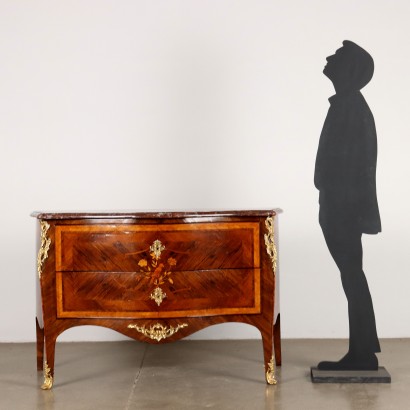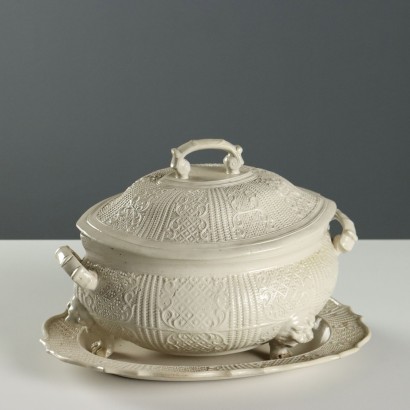Neapolitan Chest Of Drawers Rococo Red Marble Poplar Bronze Italy 1700 - Naples Third Quarter XVIII Century
Features
Naples Third Quarter XVIII Century
Style: Barocchetto (1720-1770)
Age: 18th Century / 1701 - 1800
Origin: Napoli, Campania, Italy
Main essence: Brazilian Rosewood , Tulipwood , Poplar
Material: Bronze , Brazilian Rosewood Veneer , Tulipwood Veneer , Exotic Wood Veneer , Red Marble
Description
Neapolitan Rococo chest of drawers, supported by curved feet, the under-the-top band is curved as well; on the curved front, it features two drawers with retractable chain. Quadripartite veneered wood, with double borders set at 45° degrees, the same motif is proposed in the reserves on the sides. The two drawers are decorated with a central inlay with a poly-lobed threading with a bouquet of flowers inside, inhabited by a parrot. The shaped top is in red breccia marble from the Appennini; the handles is bronzy and bronze appliqués are used on the feet, on the upper part of the uprights and in the centre of the frontal apron.
Product Condition:
Fair condition. Wear consistent with age and use. Any damage or loss is displayed as completely as possible in the pictures. Product with a Certificate of Authenticity and Lawful Origin.
Dimensions (cm):
Height: 91
Width: 143
Depth: 70
Certificate issued by: Enrico Sala
Additional Information
Style: Barocchetto (1720-1770)
This term refers, specifically to furniture, to a part of the production carried out in Italy in the period between the Rococo era and the first phase of neoclassicism.It is characterised by the formal and decorative structure still rigidly in adherence to the dictates dear to the Baroque period (hence the term barocchetto) and to the Louis XIV fashions and yet the new times can be seen in the adoption of smaller volumes, more elegant decorative modules, often directly inspired by French fashion, but always executed with rigorous principles of ornamental symmetry.
The tendency to assimilate formal and volumetric innovations but not to incorporate their ornamental elaboration finds a natural explanation in Italy in the fact that in this century the great aristocracy is experiencing an unstoppable political and economic decline.
If in the previous century there was a great profusion of furnishings intended to decorate recently built homes, to proudly show the power of the commissioning family, in In the 18th century, the focus was on updating the building with only the furniture strictly necessary for the new needs imposed by fashion or functional needs.
The old scenographic apparatus was maintained and the new must not contrast too much.
Find out more about the Barocchetto with our insights:
Classic Monday: discovering the Barocchetto
Classic Monday: between Baroque and Baroque
Classic Monday elegant and unusual with two Baroque balustrades
FineArt: Pair of Late Baroque Chairs, Venice
Emilian chest of drawers, first quarter of the 18th century, early Late Baroque
Urn shelf, Milan, mid-18th century
INSERT ADDITIONAL LINKS:
Classic Monday: The Austrian Taste of Baroque
Classic Monday: Pietro Longhi's Baroque
Classic Monday: The Sculptures of the Italian Baroque
Age: 18th Century / 1701 - 1800
18th Century / 1701 - 1800Main essence:
Brazilian Rosewood
It is a hard, light blond wood, but with strong red and pinkish veins, which is obtained from tropical trees similar to rosewood. Its veins are reminiscent of striped tulips, which is why it is called tulipwood in English-speaking areas. It is used for inlays, often combined with bois de violette. In the 1700s and 1800s it was highly appreciated and used in France and England for precious veneers. It gives off scent for decades if not centuries after curing.Tulipwood
Obtained from some types of acacia, it is a hard essence, with purplish-colored veins, used in the inlays, in which, alongside the bois de rose, it generates beautiful contrasts. Also useful for making bronze accessories stand out.Poplar
Essence considered "poor", it is a white wood, with yellowish or greyish shades, light and tender, which is easily damaged. It is used for rustic furniture or in the construction of furniture. The most valuable use it has had in the history of furniture is in Germany, in the 19th century, for veneers and inlays in the Biedermeier period.Material:
Bronze
Brazilian Rosewood Veneer
Tulipwood Veneer
Exotic Wood Veneer
Red Marble
Other customers have searched:
Scopri di più su cassettiere e comò grazie ai nostri approfondimenti:
La storia nascosta in due antichi cassettoni
Conoscere il Neoclassicismo attraverso un cassettone piacentino
Un comò piemontese influenzato dal fascino per l'Oriente
Un signorile comò rococò napoletano
Una caratteristica cassettiera con alzata emiliana di perfetto gusto barocchetto
E per gli appassionati dal gusto più raffinato, c'è FineArt:
Commode a tre cassetti G.B.M., inizio XIX secolo
Canterano dipinto
Canterano emiliano, primo quarto XVIII
Cassettone a ribalta romano, secondo quarto XVIII secolo
Comò attribuito a Luigi Viglione, Luigi XVI, fine XVIII, Torino
Coppia di comò e comodino di Maggiolini
Sull'antiquariato in generale dai un'occhiata anche a
Classic Monday: da un pezzo dei nostri magazzini alla storia dell'antiquariato
L'antiquariato dalla A alla Z: il Dizionario dell'Antiquariato
Il dizionario dell'antiquariato - Lastronatura
Il dizionario dell'antiquariato - Mascherone
Il dizionario dell'antiquariato - Natura morta
Il dizionario dell'antiquariato - Opificio
Il dizionario dell'antiquariato - Pastiglia
Il dizionario dell'antiquariato - Savonarola
Il dizionario dell'antiquariato - Rosone
Product availability
The product can be seen at Milan
Immediate availability
Ready for delivery within 2 working days from ordering the product.























































